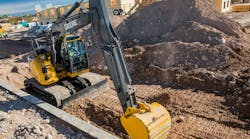My longtime auto mechanic looked at me like I was crazy. I had just told him that the onboard engine oil algorithm hadn’t triggered an oil-change signal, but the manual said not to let it go past 10,000 miles. The car was at 9,000. He strongly suggested that I start changing it every 3,000 miles and based his advice on the number of damaged engines he’s seen in cars with such indicators.
Earlier that week, the manager of a large equipment fleet told me that he was testing extended change-interval claims from his lube supplier. Although promised a move from 250 to 500 hours, he wanted to measure how the engine oil performed in his particular earthmoving machines in his particular applications.
Earlier this summer, we were watching operator-trainers from Local 150 of the International Union of Operating Engineers slot dozing with one of Komatsu’s intelligent machines, comparing automated machine control with manual dozing. The operator, although recognizing and appreciating the benefits of the technology, said he still needed to make the decision how and when to kick in the automated control.
Each of these scenes shares two characteristics: data-driven decision-making guidelines and a human being who didn’t check their brain at the door. An argument could be made for self-preservation, too, but based on what I know about each one of them, they’re not being self-serving.
Each of these scenes also illustrates how today’s fleet manager must approach the changing nature of their job responsibilities, chief of which is placing the right machine in the right person’s hands at the right time and place.
Manufacturers have rightfully incorporated technologies into their machines that improve efficiencies, reduce downtime, and maximize machine life. They are excellent digital management tools. As equipment managers acquire equipment with said technologies, however, they must determine how to use those tools.
The danger lies in presuming the technology trumps experience and fleet knowledge.
Let’s return to our three scenarios.
The car owner has to decide if he can monitor engine oil in a way that maximizes oil life without jeopardizing engine life, or whether he should just spend $35 three times rather than once every 10,000 miles.
The fleet manager will do regular oil analysis on the new oils to determine how they perform in his fleet. Eventually, he’ll have the data that will tell him how many hours the engine lubes will protect his machines in his application. He will build his PM schedules accordingly.
Local 150’s operator told us exactly how he’d approach the application in which hard-packed Illinois soil had to be slot dozed: He’d scarify the crust then set the machine control to move the dirt.
“Trust, but verify,” President Ronald Reagan liked to say. The same should apply to digital mapping, telematics, and other machine technologies. Professional equipment managers must continue to rely on their experience as they find ways to use new technological tools to the benefit of their projects.






